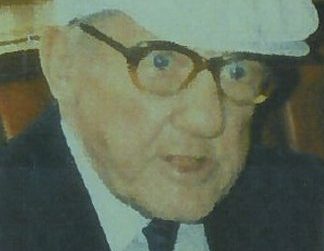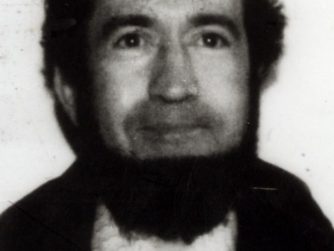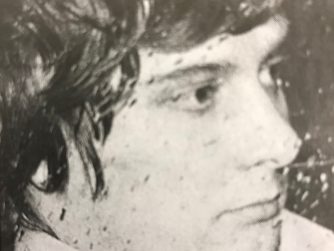
Australian Janie Shepherd came from an affluent background. The daughter of prosperous, middle class Sydney couple Angela and Anthony Shepherd, for the first few years of her life Janie knew little but happiness and security. But the Shepherd family was to have to endure tragedy, beginning with the death of Janie’s father Anthony from a heart attack when Janie was just 11 years old. Some years later, her mother Angela remarried to a friend of the Shepherd family, wealthy merchant banker John Darling. Janie loved him dearly and John in return treated her like his own daughter. John was successful in business and managed to rise to the position of chairman of British Petroleum in Australia, meaning that the Shepherd family was to travel frequently throughout Europe. For stability, Janie was educated at a private boarding school which she enjoyed, being remembered as a happy, popular and studious pupil with plenty of admirers. Between terms, she enjoyed various holidays with her parents, and it was on one of these holidays in 1973 where she discovered the place she was to love, and to meet the love of her life at: London.
It was also London where the second major tragedy was to strike the Shepherd family, because in 1977 it was in London that Janie was murdered.
In 1977, 24 year old Janie enjoyed what was pretty much the perfect life. She had discovered a love for London whilst on holiday there, and had moved over in 1976 to live. She was attractive, outgoing and had lots of friends. A generous allowance from her stepfather gave her more than enough to live independently on, but Janie was a people person and chose to work, being employed at the Caelt Art Gallery, a small independent gallery in the bustling and culturally mixed area of Westbourne Grove, just off West London’s Notting Hill Gate. It was a job that she enjoyed thoroughly. Janie had not bought a flat of her own in London, instead living in a flat in St John’s Wood with her cousin Camilla and Camilla’s husband Alistair Simpson. This was only intended as a temporary measure, as she was planning to get a place together with the man she had fallen madly in love with, her boyfriend of over a year, merchant banker Roddy Kincaid-Weeks. The couple were very happy, were madly in love, and enjoyed spending lots of time together, and the weekend of the 4th to the 6th February 1977 was to be no different.

At 8:40pm on the night of Friday 4th February, Janie had planned to pick up a supper of smoked trout, celery and cheese for the pair on her way over to Roddy’s flat, 3 miles away in the Knightbridge area of Lennox Gardens. They were due to spend the weekend together, and Roddy was expecting her for about 9:00pm, but when she hadn’t arrived by 9:30pm he became concerned. Although Friday night traffic in the West London area was severe at the best of times, it should not have taken her so long. His concern turned to worry when at 9:30pm he telephoned Camilla and Alistair Simpson to see if Janie had left the flat, only to be told that she had left nearly an hour before. He rang back thirty minutes later, and thirty minutes after that, but there was still no word from Janie. Both Roddy and the Simpsons subsequently rang hospitals in the local area to see if a woman matching Janie’s description had been admitted after an accident, but this proved negative. Finally, at 3:15am Janie was reported as a missing person by both Alistair Simpson and Roddy Kincaid-Weeks to St John’s Wood and Chelsea police stations, respectively.
Police realised near enough instantly that Janie was not the type of person to disappear deliberately – she was happy, stable and very in love with her boyfriend. She had no money worries, and there was no question of her being involved in any illegal or immoral activity. It was quite probable, almost from the off, that Janie had come to some harm. What police were aware of, and were increasingly concerned about, was the possibility that Janie had been kidnapped. They knew that she was from a very wealthy family, and the possibility loomed large that someone, knowing Janie’s family would pay any ransom to get their daughter back, had snatched her and was holding her for ransom. Bearing this in mind, the search for her got underway and a detailed description of Janie was circulated, down to the clothing and jewellery she was wearing, the possessions she was carrying, and the details of her car.

When she left the flat she shared with Camilla and Alistair, Janie had been wearing jeans and brown Cossack style boots, a dark polo neck sweater with a man’s check shirt over it, and a white cardigan with a reindeer motif on it. She had several items of jewellery, including a large gold bangle, a Russian wedding style ring, and a Gucci wristwatch on a grey leather strap. Around her neck was a thin gold chain, containing a gold charm of the character “Woodstock” from the Charlie Brown cartoon strip. Her handbag contained about £40 in cash, a tapestry that she had been working on, several balls of wool and knitting needles, clean underwear and a change of clothing, consisting of a black sweater with a bright red polo neck, and bright green cuffs. Nothing that would suggest she was going to do anything other than spend a quiet relaxing weekend with her boyfriend.

Janie’s car was a blue mini with the registration number KGM 300P that she was in the process of trying to sell, so it was clean and shiny inside and out at the time of her disappearance, and had a FOR SALE sign taped to the rear window. A description of Janie and her car was circulated within the hour of her being reported missing, and a check of the Police National Computer was undertaken to ascertain if the Mini had been spotted anywhere, had been stolen, or had been involved in an accident. But nothing showed up.
After a harrowing three days, with Janie’s loved ones waiting anxiously for any news, there was an ominous breakthrough on Tuesday 8th February 1977. Four days after Janie had last been seen, her Mini was found parked in Elgin Crescent, Notting Hill Gate – but there was no sign of Janie with it. This discovery strengthened the fears of investigators that Janie had come to harm, indeed, may never be seen alive again. The car was parked illegally on double yellow lines, and had had two parking tickets posted on it, one dated Monday 7th February at 11:45 am; and one from 12:00 pm the day it was discovered. The state of the car was a far cry from the clean and polished state Janie had set off in it in – it was filthy dirty and had mud spattered all over the bodywork. The interior of the car was in a dishevelled state, and chillingly, two parallel slash marks that had obviously been caused with a large weapon had been made in the sun roof. There were also traces of semen found in the car, cigarette butts, and interestingly, peanut shells. In the back footwell, Janie’s boots and red shoulder bag lay on the floor – but the contents of the bag were nowhere to be found, apart from two receipts – that were to give police their first clue.

One was from the Europa Foods supermarket in Queensway, where Janie had bought the supper intended for her and Roddy. More importantly, the other was from a self service petrol station in Bayswater – which showed that Janie had topped up the 7 gallon petrol tank of the Mini with three gallons of petrol on the night that she disappeared. From this, and by examining the remaining contents of the Mini’s fuel tank, police were able to estimate that the Mini could have travelled up to 75 miles between Janie filling it on the Friday, and its discovery on the Tuesday. But this left police a massive area to search, because it took in several different counties with no sure way of choosing the correct area to begin to search.
But it was a start, and with the investigation being spearheaded by Detective Chief Superintendent Henry Mooney – famous for being the man responsible for the arrest and conviction of the Kray twins – the police enquiry got underway, beginning with a police search starting from that spot. Police officers soon found the groceries Janie had bought that Friday evening discarded in various back gardens in the area nearby to where the Mini was found, which spurred their search further. Helicopters utilising infra red cameras scoured the area looking for Janie, and for the first time in British criminal history, specially trained cadaver dogs were brought in to try and find a body. A direct appeal was made to the public, and posters were distributed showing the now canonical picture of Janie Shepherd, and a picture of the Mini as it had been found in Elgin Crescent.
By Wednesday 9th February, Janie’s mother and stepfather had arrived in London. Both were distraught and willing to assist officers in whatever way that they could. They were able and of course only willing to pay any ransom demand should one arrive from someone who had kidnapped Janie, but all the while dreading more and more that the unthinkable had happened. When no ransom demand had arrived as more and more days passed, the Darlings decided to help in the search themselves. For the next month or so, 65 days in total, each day the Darlings left the flat in the St James area of West London they were staying in, and took themselves off to remote areas in parts of the country that the Mini could have theoretically visited. They explored remote copses, lonely lanes, and hedgerows all over the different neighbouring counties searching for any clue as to the whereabouts of Janie – but they never found her.
Police theorised that whoever had abducted Janie was not a first time offender – this was a practised attack that had been refined over time, and as the car was found only a few streets away from where Janie was last seen, they worked on the theory that the offender was local to, or had good local knowledge of the Notting Hill area. A check on all local sex offenders was performed – and although this was to lead to at least 18 other crimes being detected and solved – it did not instantly lead police to Janie’s abductor. But a further search of unsolved attacks in similar circumstances to Janie’s disappearance did, however, lead to an ominous precursor.
In June 1976, there had been a horrific attack, again on a young woman and again in a car, in Chesterton Street, Kensington. This was a mere half mile from the street where Janie’s car had been found abandoned. In the June 1976 attack, the victim was similar in description to Janie, a young, blonde white woman. The victim had driven home from her boyfriends flat quite late at night, and had just parked up when a black male approached the vehicle, knocked on the driver’s door window and asked her what time it was. As she was glancing at her watch to tell him, he wrenched open the driver’s door, pushed her into the passenger seat and, holding the terrified woman at knifepoint, drove to a railway arch in a nearby back street. Here she was subjected to a horrific, brutal two hour catalogue of rape. Midway through the assault, a woman walked past the vehicle pushing a baby in a pram. To dissuade the victim from calling out for help, the attacker said menacingly:
“Don’t think about shouting for help. I’ll kill you and then I’ll kill that woman and her baby.”
Before fleeing, after claiming that he “hated all white bitches”, the attacker viciously slashed the victim’s left wrist, almost severing her hand. He then ran off into the night. With blood pumping out of the wound, the victim somehow managed to drive home. She was found collapsed on her doorstep by a neighbour, and rushed to hospital, where a blood transfusion was to save her life. Doctors who saved her life claimed that she had lost so much blood that she was mere minutes from death, and that they believed the knife attack was deliberately intended to kill her. Police agreed. When the victim had recovered sufficiently enough to tell police what had happened, she described the rapist as being a powerfully built black male, in his mid 30’s, with a noticeable scar on his face. He had smoked during the assault, and had at several times professed his hatred of white women. He had also forced the victim to profess her enjoyment whilst assaulting her.
It seemed to DCS Mooney that this could have been a carbon copy of what had happened to Janie, a theory strengthened by the fact that the June 1976 attack had so far remained unsolved. He and his team were sure that this attack and Janie’s disappearance were linked, and set about looking at known offenders who could fit the pattern. One name jumped out at the investigators almost immediately, due to his crimes and the modus operandi used in them, making him a strong suspect in both crimes. In 1970, a man had been sentenced to twelve years imprisonment for a series of horrific knifepoint attacks and rapes in the Shepherd’s Bush area of London. The tabloids had christened the attacker, “The Beast Of Shepherd’s Bush”, and in four out of the five cases the man had been charged with, the victims had been young white women attacked at knifepoint in their own cars. He had been paroled early in 1976 after coming to the aid of a prison warder during a prison riot.
The man’s name was David Lashley.
To be continued
The True Crime Enthusiast




